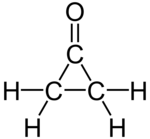
Summary
Cyclopropanone is an organic compound with molecular formula (CH2)2CO consisting of a cyclopropane carbon framework with a ketone functional group. The parent compound is labile, being highly sensitive toward even weak nucleophiles. Surrogates of cyclopropanone include the ketals.[1]

| |
| Names | |
|---|---|
| Preferred IUPAC name
Cyclopropanone | |
| Identifiers | |
| |
3D model (JSmol)
|
|
| ChemSpider |
|
PubChem CID
|
|
CompTox Dashboard (EPA)
|
|
| |
| |
| Properties | |
| C3H4O | |
| Molar mass | 56.06326 |
| Appearance | colorless |
| Density | 0.867 g/mL at 25 °C |
| Melting point | −90 °C (−130 °F; 183 K) |
| Boiling point | 50 to 53 °C (122 to 127 °F; 323 to 326 K) at 22 mmHg |
Except where otherwise noted, data are given for materials in their standard state (at 25 °C [77 °F], 100 kPa).
Infobox references
| |
Preparation edit
Cyclopropanone has been prepared by reaction of ketene with diazomethane.[1][2] These solutions are stable at −78 °C. In the presence of protic reagents such as carboxylic acids, primary and secondary amines, and alcohols, cyclopropanone converts to adducts, which are often isolatable at room temperature:[3][4]
- (CH2)2CO + X-H → (CH2)2C(X)(OH)
(X-H = R2N-H, HO-H, RO-H)
Structure and bonding edit
The C3O atoms are coplanar. As deduced from the microwave spectrum, the H2C-CH2 bond length of 157.5 pm is unusually long. By contrast, the C-C bond lengths in cyclopropane are 151 pm. The C=O bond length of 119 pm is short compared to the 123 pm bond length in acetone.[1]
The value of νC=O in the infrared spectrum is near 1815 cm−1, ca. 70 cm−1 higher than values for a typical ketone.
Derivatives edit
Cyclopropanones are intermediates in the Favorskii rearrangement with cyclic ketones where carboxylic acid formation is accompanied by ring-contraction.
Cyclopropanones react as 1,3-dipoles in cycloadditions for instance with cyclic dienes such as furan.[1] An oxyallyl intermediate or valence tautomer (formed by cleavage of the C2-C3 bond) is suggested as the active intermediate or even a biradical structure (compare to the related trimethylenemethane).
Other reactions of cyclopropanones take place through this intermediate. For instance enantiopure (+)-trans-2,3-di-tert-butylcyclopropanone racemizes when heated to 80 °C.[5]
An oxyallyl intermediate is also proposed in the photochemical conversion of a 3,5-dihydro-4H-pyrazole-4-one with expulsion of nitrogen to an indane:[6]
In this reaction oxyallyl intermediate A, in chemical equilibrium with cyclopropanone B attacks the phenyl ring through its carbocation forming a transient 1,3-cyclohexadiene C (with UV trace similar to isotoluene) followed by rearomatization. The energy difference between A and B is 5 to 7 kcal/mol (21 to 29 kJ/mol).
Coprine edit
The cyclopropanone derivative 1-aminocyclopropanol occurs naturally by hydrolyzes of coprine, a toxin in some mushrooms. 1-Aminocyclopropanol is an inhibitor of the enzyme acetaldehyde dehydrogenase.[7]
See also edit
- Other cyclic ketones: cyclobutanone, cyclopentanone, cyclohexanone
- Other cyclopropane derivatives: cyclopropene, cyclopropenone
References edit
- ^ a b c d Wasserman, Harry H.; Berdahl, Donald R.; Lu, Ta-Jung (1987). "The Chemistry of Cyclopropanones". PATAI'S Chemistry of Functional Groups: Cyclopropyl Group. pp. 1455–1532. doi:10.1002/0470023449.ch23. ISBN 9780470023440.
- ^ Turro, Nicholas J. (1969). "Cyclopropanones". Accounts of Chemical Research. 2: 25–32. doi:10.1021/ar50013a004.
- ^ Salaün, J.; Marguerite, J. (1985). "Cyclopropanone Ethyl Hemiacetal from Ethyl 3-Chloropropanoate". Organic Syntheses. 63: 147. doi:10.15227/orgsyn.063.0147.
- ^ Salaun, Jacques (1983). "Cyclopropanone Hemiacetals". Chemical Reviews. 83 (6): 619–632. doi:10.1021/cr00058a002.
- ^ Greene, Frederick D.; Sclove, David B.; Pazos, Jose F.; Camp, Ronald L. (1970). "Thermal reactions of a cyclopropanone. Racemization and decarbonylation of trans-2,3-di-tert-butylcyclopropanone". Journal of the American Chemical Society. 92 (25): 7488. doi:10.1021/ja00728a051.
- ^ Moiseev, Andrey G.; Abe, Manabu; Danilov, Evgeny O.; Neckers, Douglas C. (2007). "First Direct Detection of 2,3-Dimethyl-2,3-diphenylcyclopropanone". The Journal of Organic Chemistry. 72 (8): 2777–2784. doi:10.1021/jo062259r. PMID 17362038.
- ^ Wiseman, Jeffrey S.; Abeles, Robert H. (May 2002). "Mechanism of inhibition of aldehyde dehydrogenase by cyclopropanone hydrate and the mushroom toxin coprine". Biochemistry. 18 (3): 427–435. doi:10.1021/bi00570a006. PMID 369602.


